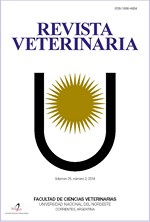In vitro digestibility of Paspalum notatum in ruminal fluid of buffaloes (Bubalus bubalis) and bovines (Bos indicus)
DOI:
https://doi.org/10.30972/vet.3114631Keywords:
Buffaloes, bovines, Paspalum notatum, in vitro digestibility, ruminal liquidAbstract
The aim of this experiment was to evaluate the in vitro digestibility coefficients of dry matter (IVDMD) and in vitro organic matter digestibility (IVOMD) of mature Paspalum notatum grass in buffaloes (Bubalus bubalis) and cattle (Bosindicus). For in vitro digestibility, ruminal fluid from one animal of each species was used; animals previously had a period of adaptation to the diet. In vitro digestibility was performed by the Tilley & Terry method (1963). Significant differences in digestibility were found for both species, IVDMD: 20.31% vs. 17.91%, standard error mean (SE): 0.6448; IVOMD: 20.30% vs 15.68%, SE: 1.7429 for buffalos and bovines, respectively.
Downloads
References
Angulo RA, Noguera RR, Berdugo JA. 2005. El búfalo de agua (Bubalus bubalis), un eficiente utilizador de nutrientes: aspectos sobre fermentación y digestión ruminal. Liv Res Rural Develop 17: 67-71.
Ayres JF. 1991. Sources of error with in vitro digestibility assay of pasture feeds. Grass & Forage Sci 46: 89-97.
Association of Official Analytical Chemists (AOAC). 2000. Official Methods of Analysis, 18º ed., Association of Official Analytical Chemists, Arlington, USA.
Bartocci S et al. 1997. Solid and fluid of passage rate in buffalo, cattle and sheep fed diets with different forage to concentrate ratios. Livest Prod Sci 52: 201-208.
Chanthakhoun V, Wanapat M, Kongmun P, Cherdthong A. 2012. Comparison of ruminal fermentation characteristics and microbial population in swamp buffalo and cattle. Livestock Sci 143: 172-176.
Delgado DC, Rosabal Y, Cairo J. 2005. In situ ruminal degradability of Pennisetum purpureum Cuba CT-115 in commercial river buffaloes and zebu. Cuban J Agric Sci 39: 181-189.
FEDNA (Fundación Española para el Desarrollo de la Nutrición Animal). 2010. Tablas de composición y valor nutritivo de alimentos para la fabricación de piensos compuestos, 3ª ed., FEDNA., Madrid, España. http://www.fundacionfedna.org/
FAO. 2006. Livestock’s long shadow: environmental issues & options. Food & Agriculture Organization, http://www.fao.org/docrep/010/a0701e/a0701e00.HTM
Franzolin R. 1994. Feed efficiency: a comparison between cattle and buffalo. Buffalo Journal 2: 39-50.
Holden LA. 1999. Comparison of methods of in vitro dry matter digestibility for ten feeds. J Dairy Sci 82: 1791-1794.
Hussain I, Cheeke PR. 1996. Evaluation of annual ryegrass straw corn juice silage with cattle and water buffalo: Digestibility in cattle vs buffalo, and growth performance and subsequent lactational performance of Holstein heifers. Anim Feed Sci & Techn 57: 195-202.
Lorenzoni WR, Campos J, Garcia JA, Coelho JF. 1986. Ganho de peso, eficiencia alimentar e qualidade da carcaça de novilhos búfalos, nelores, holandeses e mestiços holandes-cebú. Rev Soc Bras de Zoot 15: 486-497.
Lourez RR. 2001. Buffalo production systems in American. The buffalo: an alternative for animal agriculture in the third millennium. Anales VI World Buffalo Congress, Maracaibo, Venezuela.
Mendes A, Lima FC. 2011. Aspectos nutricionales del búfalo. Rev Tecnol en Marcha 24: 105. http://revistas.tec.ac.cr/index.php/tec_marcha/article/view/16915. National Research Council (NRC). 2001. Nutrient requirements of dairy cattle, 7th ed., Nat. Acad. Press, Washington, DC.
Servicio Nacional de Calidad y Salud Animal (SENACSA). 2019. Estadística Pecuaria 2018. Disponible en: http://www.senacsa.gov.py/
Statistical Analysis System (SAS). 2001. User´s Guide, version 8.02, Statistical Analysis System Institute Inc., Cary, North Carolina, EEUU, 921 p.
Tilley A, Terry R. 1963. A two stage technique for the in vitro digestion of forage crops. J Br Grassland Soc 18: 104-111.
Downloads
Published
How to Cite
Issue
Section
License
Copyright (c) 2020 M. Torres, E. Zaracho, D. Aquino, O. L. Valiente, P. Criscioni

This work is licensed under a Creative Commons Attribution-NonCommercial 4.0 International License.
Revista Veterinaria (Rev. Vet.) maintains a commitment to the policies of Open Access to scientific information, as it considers that both scientific publications as well as research investigations funded by public resources should circulate freely without restrictions. Revista Veterinaria (Rev. Vet.) ratifies the Open Access model in which scientific publications are made freely available at no cost online.











.jpg)
.jpg)



